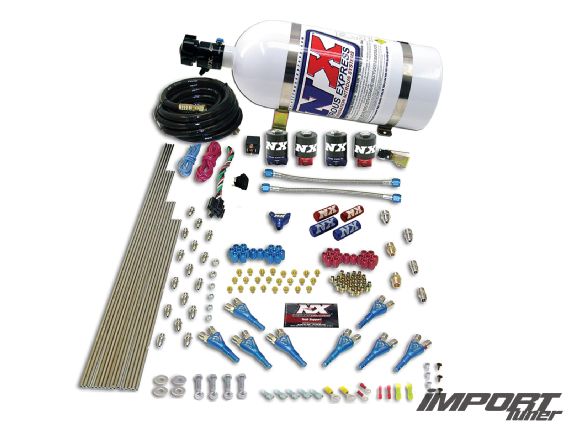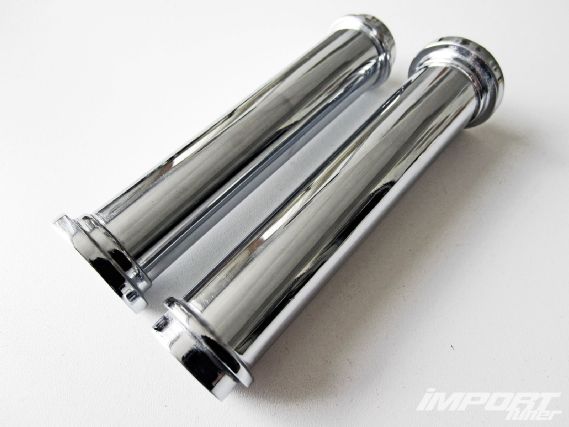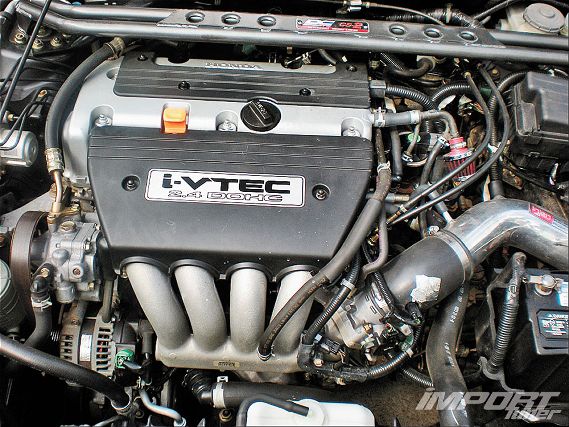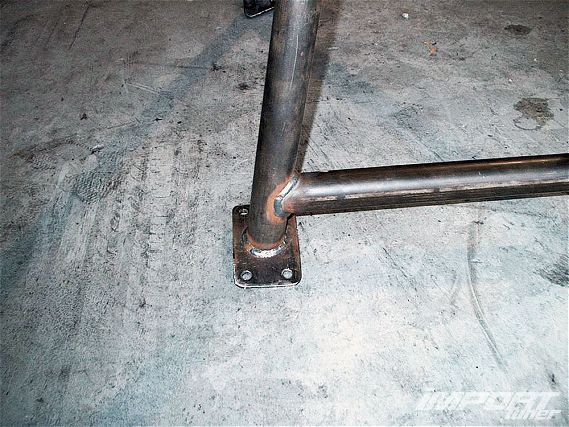 |
| www.beyondthedyno.com/blogs/eric
Got a burning question or simply need some advice with problems you've encountered while wrenching on your current/future projects? Ask our automotive guru Eric Hsu anything--literally, he's going to answer every single question, as long as it's automotive related.
Got a tech question? Send it to questionit@importtuner.com
3.5L Maxima V-6 Direct-Port Nitrous With E85
My car is a longtime project '99 Nissan Maxima with a fully built 3.5L '05 short-block (CP pistons, Carrillo rods, and balance), Cosworth heads, and ZK2 cams. The engine is controlled by the factory ECU with MAF and has 440cc DW injectors for the E85, a Walbro 418 (450-lph) ethanol pump with 6AN lines for supply and return, an Aeromotive FPR, OBX rails, and a '08 Nissan Altima intake manifold. The OBX headers and custom 3-inch collector go to a straight-through exhaust to a Flowmaster D-50 SUV muffler. Other stuff includes a built automatic from IPT in New Jersey, cryo axles, and traction bars. The car runs M&H 24.5x8x15 slicks on AR wheels or M/T ET Street radials 26x10.5x15 on Summit wheels.
 |
IMPP-130200-QUEST-
|
IMPP-130200-QUEST-
The direct-port system is built with extended tip Nitrous Outlet nozzles fed from two six-port blocks from NX 500HP Lightening solenoids controlled by an NX Maximizer 3 controller, set for throttle control. For a 150-shot, I jet nitrous for .026 in each and have been searching for a fuel jet (tried .019-.023) that gives me a Lambda of around .80 at WOT. I have also tested a single NX Shark nozzle ahead of the 75mm TB and find that (75-shot) a nitrous jet of .041 and fuel jet of .033 gives a Lambda of .083 on the PLX.
Regardless of what I do with fuel jets I cannot get the Lambda below .94-and it should be around .80 with E85 (VP Racing C85). I raised the FP; the engine bogged when spraying. I kept going to fuel jets larger than .023 and the car felt slower on the highway but no change in the Lambda reading. Something is very strange; the single-nozzle tunes fine, but the six-nozzle setup will not drop the Lambda. Is there something weird about spraying with E85 and the Bosch LSU4.2 sensor? I'm stumped here. The car pulls very hard, but I don't want to go to a track and melt down the engine by running too lean for a quarter-mile (I've done that before).
Harold Bragdon, via importtuner.com
The very first thing that comes to mind is the Bosch sensor itself. How old is the sensor and have you tried a new sensor? When Lambda sensors fail, they typically do what you are describing by not reading any richer than a specific amount (in this case .94). It's almost as if the Lambda is clipped at .94. Bosch sensors have no issues reading proper Lambdas on E85. The fact that your experiment of running larger fuel jets caused misfire and loss of power also tells me that your sensor is probably dead or dying.
Bosch LSU sensors do not last very long on leaded race fuels. While you didn't mention what kind of fuel you ran previous to E85, I would assume you ran some kind of leaded race fuel like most drag racers. Bosch LSUs are rated at 50 hours of life span with leaded fuels, but there are a lot of variables that can affect their actual life spans such as temperatures, moisture, and amplifier drive method, and more. Personally, I've had Bosch LSU sensors fail with leaded race fuel in less than four hours and some in 20, but I've never had one last the full-rated 50 hours. On the flip side, the NTK L1Hx UEGO sensors are also rated at 50 hours, but, in my experience, last much, much longer with leaded race fuels than Bosch LSU sensors. I have had a few NTK sensors last for years on leaded race fuel.
The good news is the switch to E85 will allow your Bosch LSU sensors to live a long, full life.
Exhaust Piping Diameter
I just turbocharged my '91 1.6L Mazda Miata. The new power is great, but I can tell the car needs a larger exhaust. My plan was to cut the downpipe (2.5-inch ID) 12 inches or so upstream from the cat, then go 3 inches all the way to the tailpipe (cat included). My other option is to get a 2.5-inch catback and just bolt it on. Is jumping up to a 3-inch going to make that much more of a difference than going with 2.5-inch piping? Cost is not a factor if the 3-inch pipes aren't mandrel-bent. The current setup has a MagnaFlow cat and 2.25-inch catback.
 |
IMPP-130200-QUEST-
|
IMPP-130200-QUEST-
Fred Crumley, via importtuner.com
The larger-diameter tubing makes the most difference right after the turbo. The exhaust gases exiting a turbine housing travel at the perimeter of the downpipe, so the larger the tubing, the lower the backpressure is going to be on a turbo engine.
You didn't mention how much power your Miata engine is making or the size of your turbo. These will be the main factors determining how large your exhaust should be. But since it's a smaller 1.6L engine of an older design (i.e. the heads and cams don't flow as well as modern engines), I don't think you'll have any issues with a 2.5-inch exhaust. I do, however, recommend using mandrel bends. Never cheap out on a press-bent exhaust if you can help it.
Rotary Advice
I recently bought my friend's '86 Mazda RX-7 GXL with a bridge-ported 13B S4 engine. I had heard that rotary engines come turbo-ready, but just to make sure, I thought I would ask. Is it really as easy as slapping the turbo on, or do the internals need to be swapped with parts that will hold up against boost?
Tyler DuPont, via importtuner.com
On the street and even occasional drag racing, you shouldn't have any issues boosting a normally aspirated rotary engine. Aside from the higher compression ratio of a normally aspirated engine, the NA engines use a slightly different coating on the rotor housings, have weaker stationary gears, and a tad bit less oil pressure. The coating and gears will only have durability issues in racing or sustained high rpm use. Whoever built the bridge port engine probably already used a turbo oil pressure regulator or shimmed the factory regulator.
Engine builders who build high-powered turbo engines typically also like to run different apex seals. Ceramic apex seals are unquestionably the strongest (and most expensive), but if you ask five engine builders which non-ceramic apex seal they prefer to use, you'll probably get five different answers. The factory seals can hold up to boost fine also, but there's less margin for error. The engine's life will be up to the parts selection (i.e. good intercooler and radiator) and quality of ECU and tuning with factory Mazda apex seals.
Regardless, you'll want to remove the oil pressure check spring and ball in the eccentric shaft and replace them with a plug. This will add some reliability and ensure oil flow to the rotor bearings as the ball and spring have been known to stick from time to time. Chances are the engine builder who built the bridge port already addressed it, but just a heads-up.
Since your buddy's engine is a bridge port, the power and torque curves will undoubtedly be a bit higher than a street ported engine. After turbocharging you'll find the power and torque peaks will be lower than they were normally aspirated, which will be good for engine longevity, of course.
Money Hungry
My car is a '08 Honda Fit that is almost paid off! So I was thinking about doing something to the engine, either a K20/K24 swap or something along those lines. I really wanted to do something no one has done to the Fit yet, but I can't come up with anything seeing that a lot has already been used. Would you guys have suggestions on what to do? Where should I start? I know once I walk into a shop they will see I'm a girl and suck the money out of me.
 |
IMPP-130200-QUEST-
|
IMPP-130200-QUEST-
Cindy
West Palm Beach, FL
Usually doing a swap that nobody's done before also involves using more money. The reason is that there are not going to be any off-the-shelf swap kits available and there won't be any knowledge base available for the other aspects of the swap (e.g. ECU wiring, axle selection, shift linkages, and more). Somebody will need to figure it all out from scratch and that will all go on your bill in most cases.
Aside from that, the K20/24 engines are really good and hard to beat. You could drop an H22 in, but it really isn't a better engine. Sure you'd be different, but you'd end up with an older engine that didn't make as much power with worse fuel consumption. Personally, I don't see any real value in that, but if that's what you want to be different at a car show or meet, then go ahead. Another different swap would be a 4G63 from an Evo or a B16/17/18/20.
As for the girl aspect of it, you could easily use that to your advantage. You should know that guys do stupid things for a big butt and a smile. Look at all the guys buying this magazine!
Safety First
I own a '97 Talon TSi currently limited to 524 awhp on the Mustang dyno at FFTec in Hayward, CA, until I get a 5-bar map sensor to replace my 3-bar and retune for more boost. I'd really like to run my Talon at the track, but do not have a 'cage or harness bar for my four-point Takata harnesses to mount. What 'cage would you recommend for it to still be comfortable as a street car for me and a passenger, and be able to pass tech for mid 10-second passes and have safe harness mounting points. Would a bolt-in Autopower six- or eight-point 'cage do the trick or is a weld-in custom 'cage the better way to go?
 |
IMPP-130200-QUEST-
|
IMPP-130200-QUEST-
TJ
NorCal
An Autopower rollbar isn't sold as an NHRA legal rollbar, but the NHRA rules pretty much just require a four-point rollbar to be there as long as the car runs the quarter-mile between 10.00 and 10.99 seconds. The only provision to this rule is if the car goes faster than 135 mph, then the car will need a 'cage (really a bar with door bars). This means a four-point Autopower rollbar will do the trick as long as your car is slower than 10.00 seconds and under 135 mph. Of course, the bar keeps the car the most comfortable.
Likewise, Autopower rollcages are not NHRA legal rollcages. I believe they are sold as SCCA legal 'cages. The NHRA rulebook states that door bars must be between the shoulders and elbows. So you could conceivably install an Autopower four-point rollbar in the rear and fabricate swinging/removable door bars. This will keep the car comfortable on the street and legal for the strip. An experienced fabricator should be able to do this for you cleanly-although clean is seldom cheap.
